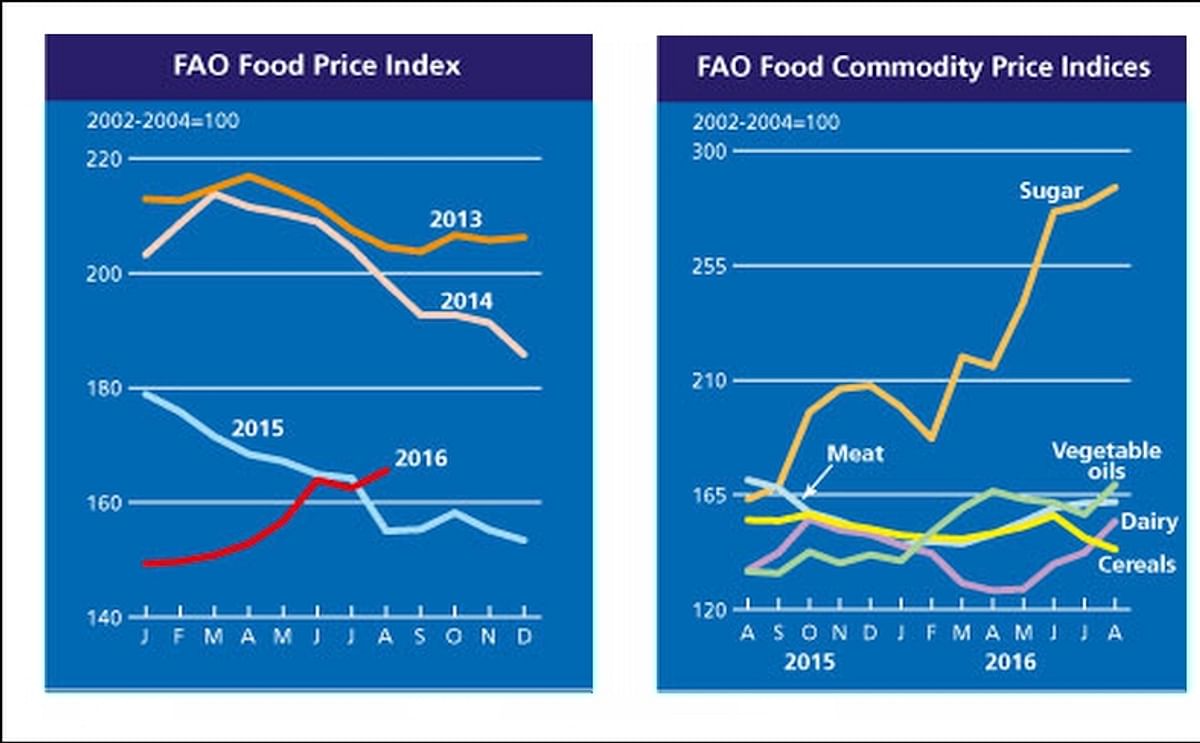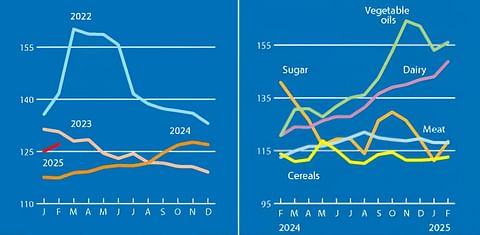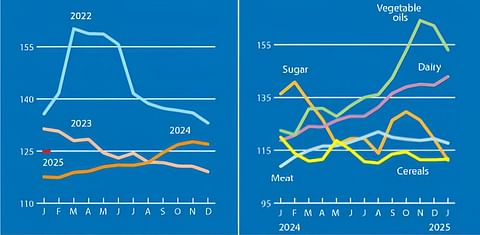The FAO Food Price Index hits a 15-month high in August
The FAO Food Price Index hits a 15-month high in August

The FAO Food Price Index (FFPI) averaged 165.6 points in August 2016, up 3 points (1.9 percent) from July and almost 7 percent above the corresponding period last year. The August value of the Index is the highest since May 2015.
Except for cereals, prices of all other commodities used in the calculation of the FFPI rose in August, led by dairy, oils and sugar.
The FAO Cereal Price Index averaged 143.6 points in August, down 4.5 points (3.0 percent) from July and 7.4 percent below its year-earlier level. Seasonal harvest pressure, associated with the completion of wheat harvests in the northern hemisphere, kept wheat quotations under some downward pressure. Maize values also receded on exceptional crop prospects in the United States and ample supplies of low quality wheat, which could compete with maize for use as animal feed. Meanwhile, a combination of thin buying interest and prospects of larger availabilities from imminent crop harvests weighed on international rice prices.
The FAO Vegetable Oil Price Index averaged 169.1 points in August, up 11.7 points (7.4 percent) from July, reversing the easing of prices observed in the preceding three months. The rebound was mainly driven by strengthening palm oil quotations due to lower than anticipated output in Malaysia and continued tightness in global inventories, which coincided with rising import demand in some key importing countries, notably China, India and the EU. International prices of rapeseed oil also firmed, reflecting lower crop prospects in the EU.
The FAO Dairy Price Index averaged 154.6 points in August, up 12.3 points (8.6 percent) from July and around 14 percent from last year. Prices rose for all the dairy commodities that compose the Index, in particular for cheese, whole milk powder and butter. The latest increase confirmed a notable change in market sentiment, as falling milk production in the EU, coupled with an unexceptional opening to the dairy year in Oceania, pointed to tighter export supply prospects than had been earlier anticipated. Skimmed milk powder quotations were muted, supported by large EU intervention stocks, which were seen as a potential future source of supply.
The FAO Meat Price Index averaged 162.2 points in August, 0.5 points (0.3 percent) higher than its revised July value but down 5 percent from August 2015. International prices for ovine meat, pigmeat and poultry meat strengthened somewhat, while quotations for bovine meat declined. Limited supplies of pigmeat in the EU and sheep meat from Oceania lent some support to prices for these products, while firm international demand, in particular from Asia, underpinned poultry meat prices. Meanwhile, recovery in bovine meat production in the United States reduced the need for external supplies and contributed to international prices falling back somewhat.
The FAO sugar price index averaged 285.6 points in August, up 6.9 points (2.5 percent) from July, reaching its highest level since October 2012 and as much as 75 percent above the corresponding period last year. The latest surge in sugar prices was largely on account of a continuous strengthening of the Brazilian currency (Real), which appreciated by another 2 percent against the US dollar in August. Expectations of a significant deficit in global markets in 2016/17 and prospects of reduced inventories in Asia also underpinned international sugar quotations.
Except for cereals, prices of all other commodities used in the calculation of the FFPI rose in August, led by dairy, oils and sugar.
The FAO Cereal Price Index averaged 143.6 points in August, down 4.5 points (3.0 percent) from July and 7.4 percent below its year-earlier level. Seasonal harvest pressure, associated with the completion of wheat harvests in the northern hemisphere, kept wheat quotations under some downward pressure. Maize values also receded on exceptional crop prospects in the United States and ample supplies of low quality wheat, which could compete with maize for use as animal feed. Meanwhile, a combination of thin buying interest and prospects of larger availabilities from imminent crop harvests weighed on international rice prices.
The FAO Vegetable Oil Price Index averaged 169.1 points in August, up 11.7 points (7.4 percent) from July, reversing the easing of prices observed in the preceding three months. The rebound was mainly driven by strengthening palm oil quotations due to lower than anticipated output in Malaysia and continued tightness in global inventories, which coincided with rising import demand in some key importing countries, notably China, India and the EU. International prices of rapeseed oil also firmed, reflecting lower crop prospects in the EU.
The FAO Dairy Price Index averaged 154.6 points in August, up 12.3 points (8.6 percent) from July and around 14 percent from last year. Prices rose for all the dairy commodities that compose the Index, in particular for cheese, whole milk powder and butter. The latest increase confirmed a notable change in market sentiment, as falling milk production in the EU, coupled with an unexceptional opening to the dairy year in Oceania, pointed to tighter export supply prospects than had been earlier anticipated. Skimmed milk powder quotations were muted, supported by large EU intervention stocks, which were seen as a potential future source of supply.
The FAO Meat Price Index averaged 162.2 points in August, 0.5 points (0.3 percent) higher than its revised July value but down 5 percent from August 2015. International prices for ovine meat, pigmeat and poultry meat strengthened somewhat, while quotations for bovine meat declined. Limited supplies of pigmeat in the EU and sheep meat from Oceania lent some support to prices for these products, while firm international demand, in particular from Asia, underpinned poultry meat prices. Meanwhile, recovery in bovine meat production in the United States reduced the need for external supplies and contributed to international prices falling back somewhat.
The FAO sugar price index averaged 285.6 points in August, up 6.9 points (2.5 percent) from July, reaching its highest level since October 2012 and as much as 75 percent above the corresponding period last year. The latest surge in sugar prices was largely on account of a continuous strengthening of the Brazilian currency (Real), which appreciated by another 2 percent against the US dollar in August. Expectations of a significant deficit in global markets in 2016/17 and prospects of reduced inventories in Asia also underpinned international sugar quotations.
Like to receive news like this by email? Join and Subscribe!
NEW! Join Our BlueSky Channel for regular updates!
Highlighted Company
Sponsored Content
Sponsored Content
Sponsored Content
Sponsored Content
Sponsored Content










